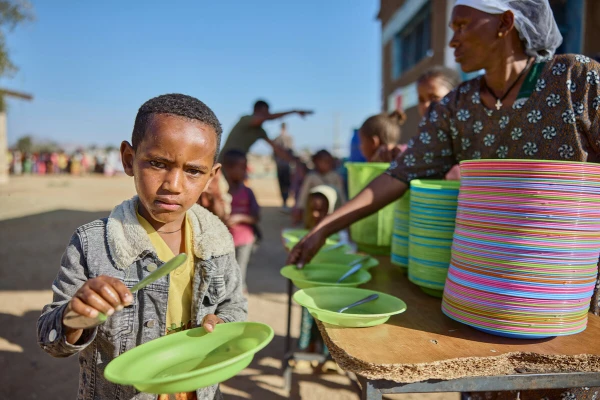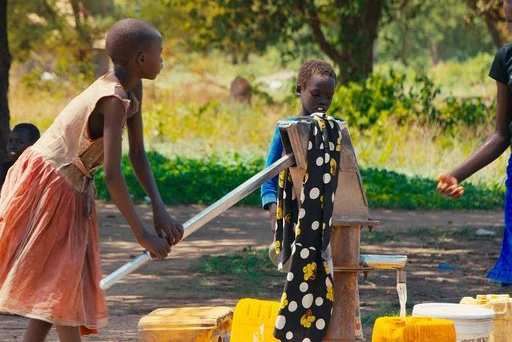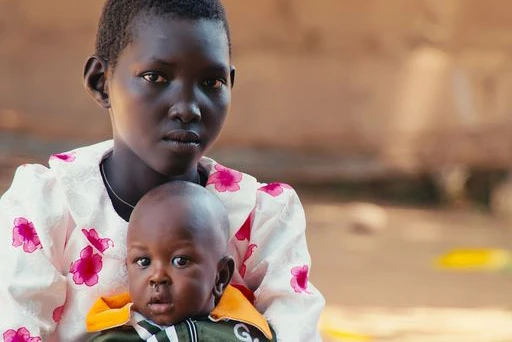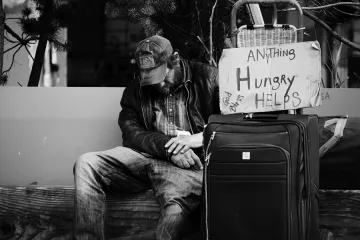CNA Staff, May 27, 2024 / 08:00 am
Every night around the world approximately 350 million people, including a vast number of children, go to bed hungry.
That’s according to the World Food Program (WFP), a major aid organization within the United Nations, which further estimates that nearly 49 million people are “on the brink of famine.”
Widespread hunger crises in some countries have lasted for many years, such as those in places like Ethiopia and Yemen. Other widespread hunger crises have exploded in some countries, such as Ukraine and Gaza, relatively recently. Regardless, famine and starvation remain largely underreported given the seriousness and breadth of the problem.
Large Catholic aid organizations such as Catholic Relief Services have sounded the alarm about the danger of famine for years. CNA spoke with several other Catholic groups tirelessly engaged in feeding the hungry about the causes of and solutions to famine.
‘God’s given us an abundance’
“Famine,” along with the commonly used term “food insecurity,” can be abstract concepts to grasp.
Food insecurity — defined by the WFP as the lack of regular access to enough nutritious food for healthy growth and development — can, of course, strike people anywhere in the world, even in highly developed nations like the U.S. But certain countries or regions in the world have a high proportion of their population that is food insecure for extended periods of time, leading in many cases to widespread deaths.
The United Nations uses a classification system to determine which countries fit the definition of “famine.” A famine classification is the highest on the scale — Phase 5 — and occurs when at least 20% of the population face extreme food shortages; acute malnutrition rates exceed 30%; and two out of 1,000 people die from starvation on a daily basis. This means that even before a famine is declared, people are dying of hunger.
Magnus MacFarlane-Barrow is the founder of Mary’s Meals, a Catholic organization that provides meals to more than 2.4 million children every school day in 17 countries across the globe.
After being pushed out by conflict in the region, Mary’s Meals recently resumed the provision of thousands of free meals daily to schoolchildren in Tigray, northern Ethiopia, in a country where more than 20 million people rely on food assistance. Ethiopia’s government claimed as of January that at least 400 people had starved to death in Tigray and Amhara regions in recent months.
It is estimated that 600,000 people died in the recent war in Tigray in an area that is overwhelmingly Orthodox Christian.
MacFarlane-Barrow told CNA this week that despite many years of improvement, hunger crises around the world have gotten more acute since the COVID-19 pandemic.
“I can’t remember a time in all the years of Mary’s Meals when it felt like there were so many simultaneous food crises unfolding at the same time,” MacFarlane-Barrow told CNA.
“All over the developing world, we see millions of people who are on the edge … because of rising food prices and because their income is not going up at the same pace, they’re falling over the edge. They simply can’t afford food … so much of it comes back to poverty.”

(Story continues below)
Mary’s Meals largely operates in what MacFarlane-Barrow calls “the darkest places, the places where children are suffering the most — where children are suffering most acutely from malnutrition.”
They use locally sourced ingredients whenever possible and rely heavily on the local Daughters of Charity to cook the food, but human conflict and climate events such as droughts and floods can seriously hamper their work.
MacFarlane-Barrow said the schools where they operate in Tigray and elsewhere provide hope, and providing free meals at the schools helps to provide an incentive for students to get educated. This leads to positive ripple effects that they’ve seen have enormous impact through generations, he said.
“None of this hunger we’re talking about, none of it is inevitable … There’s no reason why any single child in this whole world could go a day without food or be hungry in this world of plenty, in this world where God’s given us an abundance, more than we need,” MacFarlane-Barrow said.
“When we give, when we share what we’ve been given with other people in need, it makes us more fully human. I think it helps us become more the people God made us to be.”
‘The difference between life and death’
Landlocked and slightly smaller than Texas, the majority-Christian nation of South Sudan consistently ranks near the very bottom on the list of most developed countries. Despite the rich agricultural potential of the region, hunger is widespread. Conflict, corruption, and widespread poverty make for enormous challenges in the young country — young not only because it was formed only in 2011 but also because the life expectancy is a mere 59 years.
South Sudan has the largest refugee crisis in Africa with more than 2 million IDPs (internally displaced people) due to conflict, insecurity, and environmental challenges, the U.N. Refugee Agency reported in 2022. Thousands of homeless children — most orphaned by the war — roam the streets of South Sudan’s major cities. There are also more than 2 million South Sudanese refugees living in neighboring countries.
Pope Francis’ historic visit to South Sudan in early 2023 was a galvanizing event that shed an international spotlight on a beloved but severely ailing country.
Matt Smith, vice president of strategic partnerships and development at the Washington, D.C.-based Sudan Relief Fund, which has worked in the region for the past 25 years, told CNA last week that South Sudan has recently been hit by alternating weather extremes — severe drought followed in many cases by severe rains.
“Food insecurity, especially in a place like South Sudan, is still the difference between life and death,” Smith noted.
“Often, even if there is not an official designation of famine per se, the sheer volume of people in certain communities that are food insecure still, I think, necessitates urgent action just as much as if there were an official famine designation.”

After devastating civil wars from 1955–1972 and 1983–2005, fighting began again in 2013 following the country’s 2011 independence. Both sides have been accused of serious atrocities over the course of the conflict, including the raping of women, killing of civilians, and recruitment of child soldiers.
Many people in South Sudan have been internally displaced by the fighting repeatedly and have had to start their lives over multiple times. They often simply need access to simple farming tools and resources to do their jobs and feed their families, Smith said.
“South Sudan, especially in the western part of the country, has incredible access to land that should be able to be used to grow crops, to feed people en masse … There’s a deep history amongst many of the peoples across South Sudan that know how and have survived off the land for many years. It’s just a matter of making sure that they have proper tools and resources available to them … in spite of some of these challenges like the fighting and the droughts and the flooding and things like that,” he said.

In their relief work, Sudan Relief Fund’s main partner is the local Catholic Church, whose leaders are able to act as effective, credible partners to deliver aid dollars where they are most needed, responding to urgent needs on the ground. But because basic infrastructure in South Sudan is incredibly underdeveloped and much of the terrain is challenging, their work isn’t easy.
Still, Smith said it is always inspiring to him to visit the country and see the joy and resilience of the people.
“What stood out to me was just the incredible resilience of people in this part of the world and the mental and physical strength in some of the harshest conditions on earth,” he said.
“And yet still there’s a smile on their face and still they’re willing to talk to me and still they’re willing to share their story with me. And so I think [that is] one of the things that’s shown through.”
‘Do something that is going to be lasting’
Food insecurity and hunger can strike even in countries where famine hasn’t been declared. In those countries, long-term assistance is often needed to help people build resilience and feed themselves and their families.
In central Kenya, several years of drought plus recent torrential flooding has exacerbated food insecurity. Based in the town of Meru, Wanjiku Marius is a coordinator for Unbound, a Catholic-founded U.S. charitable organization that assists 6,400 beneficiaries in the region, mostly mothers.
Ninety percent of those beneficiaries live in a semi-arid region, and most families have small-scale farms that they use to feed themselves. They rely heavily on rainfall, and drought conditions have affected the farmers’ ability to grow the staple crops of maize, bananas, and beans as well as the availability of farm jobs.
Marius said Unbound facilitates cash transfers to the mothers to assist with nutrition, home repair, and education and that they encourage the farmers to plant drought-tolerant crops like sorghum and millet. The biggest need, she said, is water.
“The families in that region are very hardworking. It’s a very hardworking community. So what they lack is just that basic necessity,” she said, adding that Unbound is able to “do something that is going to be lasting” by assisting with the pumping of water from wells.
A big problem at the moment, however, is an excess of water from the recent flooding. Marius said “maybe about 100 people” out of their beneficiaries have been affected by the recent flooding, which has destroyed homes, crops, and infrastructure vital for mobility.
Peter Ndungo, who also works for Unbound as program coordinator for its Nairobi project, currently oversees the serving of 12,174 beneficiaries in 11 regions, the furthest of which is four hours from Nairobi. He said the big capital city of Nairobi depends heavily on the “breadbasket” of Kenya, where many of Marius’ beneficiaries live.
He requested prayers for those devastated by the drought and floods, and said Unbound is able to help the families they serve in part through a savings and credit cooperative that allows people without access to credit to get low-interest loans. The co-op is funded through money from Unbound’s sponsors.
“Sponsorship money will help them balance between educating their children and also having a well-balanced meal,” Ndungo told CNA. “Food security is a major problem in our city and also in areas where we serve the rural communities.”






